2022-07-14 • Not directly connected but detected
Contents
2022-07-14 • Not directly connected but detected¶
Params¶
Based on Roxin (see previous nb).
d = 6
p = get_params(
duration = 10minutes,
p_conn = 0.04,
g_EE = 1 / d,
g_EI = 18 / d,
g_IE = 36 / d,
g_II = 31 / d,
ext_current = Normal(-0.5 * pA/√seconds, 5 * pA/√seconds),
E_inh = -80 * mV,
to_record = [1, 801],
);
# dumps(p)
Conntest¶
m = 1 # ID of recorded excitatory neuron
v = s.signals[m].v
ii = get_input_info(m, s, p);
ii.num_inputs
(exc = 26, inh = 10)
length(ii.unconnected_neurons)
963
(There was a bug where m itself was included in unconnected_neurons. See related notebook in Unpolished section. Now fixed).
perf = evaluate_conntest_perf(v, ii.spiketrains, p);
Testing connections: 100%|██████████████████████████████| Time: 0:00:589m
perf.detection_rates
(TPR_exc = 0.154, TPR_inh = 1, FPR = 0.15)
So we’re investigating those 15% false positives, which would be 5% if directly-unconnected spiketrains were not related to the voltage signal.
signif_unconn = ii.unconnected_neurons[findall(perf.p_values.unconn .< p.evaluation.α)]
6-element Vector{Int64}:
4
5
14
16
22
37
tested_unconn = ii.unconnected_neurons[1:p.evaluation.N_tested_presyn]
show(tested_unconn)
[2, 3, 4, 5, 6, 7, 8, 9, 10, 12, 13, 14, 15, 16, 17, 18, 19, 20, 21, 22, 23, 24, 25, 26, 27, 28, 29, 30, 31, 32, 34, 35, 36, 37, 38, 39, 40, 41, 42, 43]
length(signif_unconn) / length(tested_unconn)
0.15
(The eval_conntest_perf function takes the first N_tested_presyn = 40 of the spiketrains it’s given).
STAs¶
STAs = [calc_STA(v, s.spike_times[n], p) for n in signif_unconn]
ylim = [minimum([minimum(S) for S in STAs]), maximum([maximum(S) for S in STAs])] ./ mV
for n in signif_unconn
_, ax = plt.subplots(figsize=(2.2, 1.8))
plotSTA(v, s.spike_times[n], p; ax, ylim)
end
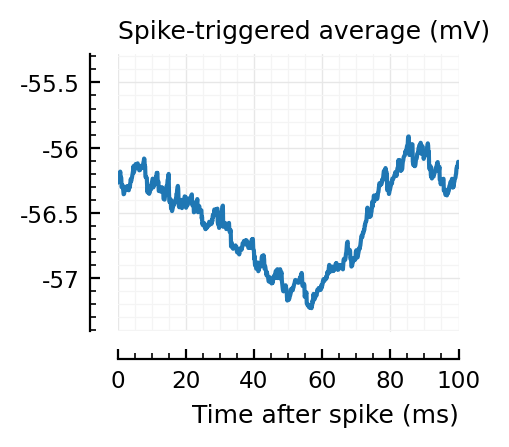
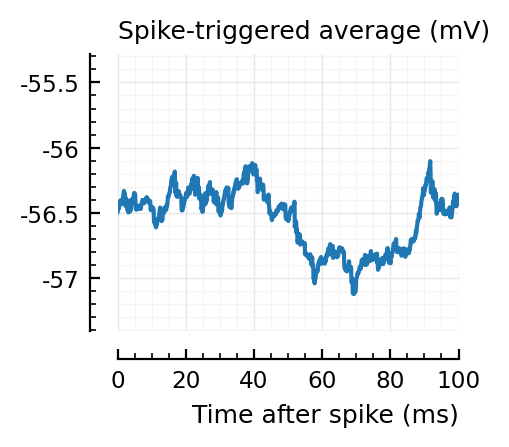
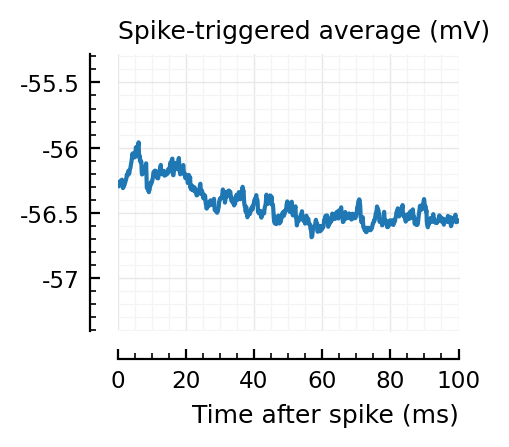
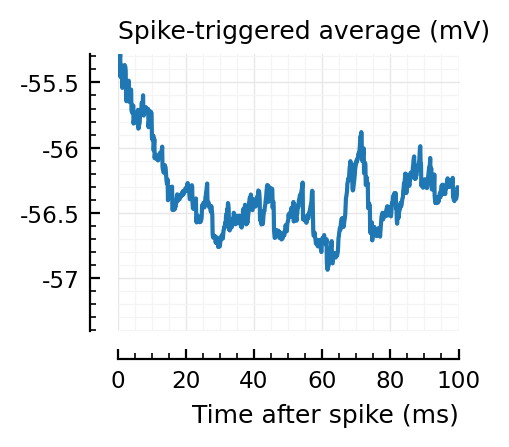
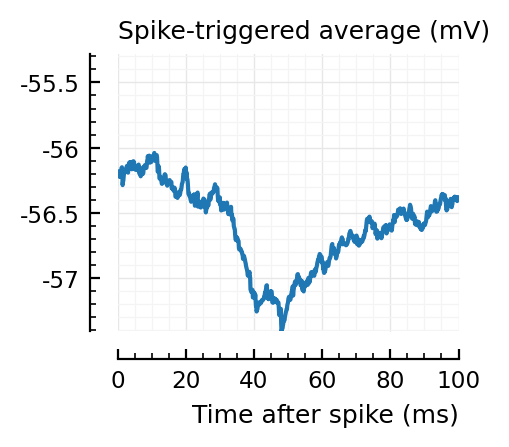
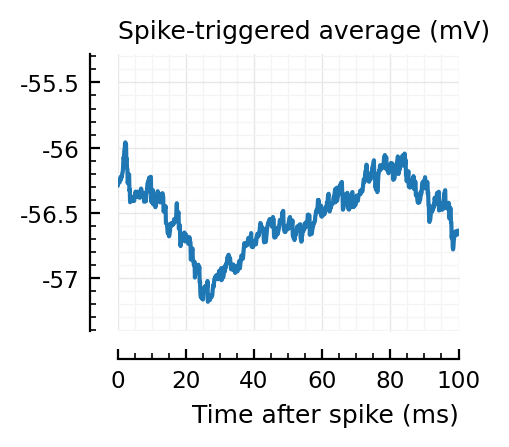
New shuffle seed¶
We expect 2/6 (so 2 / 40 tested, i.e. 5%) to change, depending on shuffle.
So let’s try another test.
We do need to set the rng seed manually as the test sets it for reproducibility.
p2 = @set p.evaluation.rngseed = 1;
perf2 = evaluate_conntest_perf(v, ii.spiketrains, p2);
Testing connections: 100%|██████████████████████████████| Time: 0:01:04
perf2.detection_rates
(TPR_exc = 0.115, TPR_inh = 1, FPR = 0.125)
signif_unconn2 = ii.unconnected_neurons[findall(perf2.p_values.unconn .< p.evaluation.α)]
5-element Vector{Int64}:
4
14
16
22
37
signif_unconn
6-element Vector{Int64}:
4
5
14
16
22
37
So all except 5 are common between both shuffle seeds.
Paths¶
Let’s start by finding the shortest path of each of those significant-but-not-directly-connected neurons to our target neuron.
Breadth first search.
function shortest_path(start::Int, target::Int, outputs::Dict{Int, Vector{Int}} = s.output_neurons)
paths = Deque{Vector{Int}}()
push!(paths, [start])
while true
path = popfirst!(paths)
if last(path) == target
return path
end
new_paths = [[path..., o] for o in outputs[last(path)] if o ∉ path]
push!(paths, new_paths...)
end
end;
for n in signif_unconn
println(shortest_path(n, m))
end
[4, 66, 1]
[5, 66, 1]
[14, 831, 1]
[16, 169, 1]
[22, 565, 1]
[37, 11, 1]
So they are all one hop away.
Expected number of hops¶
What is the overall distribution of shortest path lengths to this neuron?
This is a bit slow using the above method.
So googling → https://www.wikiwand.com/en/Floyd–Warshall_algorithm, which finds all shortest paths in an adjacency matrix.
function shortest_distances(A)
pre_post_pairs = Tuple.(findall(A))
N = size(A)[1]
inf = N
dist = fill(inf, (N, N))
for (m,n) in pre_post_pairs
dist[m,n] = 1
end
for n in 1:N
dist[n,n] = 0
end
for k in 1:N
for i in 1:N
for j in 1:N
dk = dist[i,k] + dist[k,j] # distance of path through k
if dist[i,j] > dk
dist[i,j] = dk
end
end
end
end
return dist
end;
A = s.is_connected
@time D = shortest_distances(A)
9.155121 seconds (132.96 k allocations: 15.890 MiB, 0.97% compilation time)
1000×1000 Matrix{Int64}:
0 3 3 2 2 3 2 2 1 1 2 2 1 … 3 2 2 3 2 2 2 2 2 2 2 1
2 0 2 2 2 2 2 2 2 2 3 2 2 3 2 2 2 3 3 3 2 2 2 2 2
2 2 0 2 2 2 2 2 3 3 1 2 3 3 2 2 2 2 2 2 2 2 2 3 2
2 2 2 0 2 2 2 2 2 2 3 2 3 1 3 3 2 2 1 2 3 2 2 3 2
2 1 2 2 0 2 2 3 3 1 2 2 2 2 1 2 2 2 3 2 2 3 2 2 3
2 1 2 2 3 0 2 2 2 2 2 2 2 … 3 3 3 2 3 3 3 2 2 3 3 3
2 2 2 2 2 2 0 2 2 2 2 2 2 2 2 2 2 2 2 2 2 2 3 3 2
2 2 2 1 2 2 2 0 2 2 2 2 2 2 2 2 2 2 2 2 2 2 2 2 3
2 2 2 2 2 3 3 2 0 2 1 2 2 2 2 2 2 2 2 3 3 2 2 2 1
2 2 2 2 2 2 3 2 2 0 2 2 2 2 2 2 2 2 2 2 2 2 2 2 2
1 2 2 2 2 2 2 2 2 2 0 1 2 … 2 1 2 3 2 2 2 3 2 2 2 2
3 2 2 2 2 2 2 2 2 2 2 0 3 2 2 3 2 2 2 1 2 2 2 2 2
2 3 2 2 2 2 1 3 3 3 2 2 0 2 2 2 2 3 2 3 3 2 2 2 1
⋮ ⋮ ⋮ ⋱ ⋮ ⋮
2 2 2 2 2 3 2 3 2 2 2 2 2 0 2 2 3 2 2 2 2 3 2 2 2
2 2 2 2 2 2 3 2 2 2 2 2 3 2 0 2 2 2 2 2 2 2 3 2 2
2 2 2 2 2 2 2 2 2 2 2 2 2 … 2 2 0 2 2 2 3 3 2 3 2 1
2 2 3 2 2 3 2 2 2 3 2 2 2 3 3 3 0 1 2 2 3 2 3 3 3
3 2 2 3 2 2 1 2 2 2 2 2 2 2 2 2 2 0 2 3 2 2 2 2 2
2 2 3 2 3 3 2 2 3 2 2 2 3 3 2 2 3 3 0 2 2 2 2 3 2
3 2 2 2 2 2 1 2 2 2 2 2 3 2 2 2 2 2 2 0 2 2 2 2 2
3 2 2 2 2 2 2 2 2 3 3 2 2 … 3 2 2 2 2 2 1 0 2 2 2 2
2 2 2 2 3 2 2 2 2 2 2 2 2 2 2 3 2 2 2 2 2 0 2 3 2
3 2 3 2 2 3 2 2 1 2 2 2 2 2 2 2 2 1 2 3 3 2 0 2 2
2 2 1 2 3 2 2 3 2 3 2 2 2 2 2 2 2 1 3 2 3 2 2 0 2
3 2 3 3 2 2 2 3 2 2 3 2 2 2 2 2 2 2 2 2 3 2 2 2 0
So to answer the question (overall distribution of path lengths to our recorded neuron):
distances = D[:, m];
deleteat!(distances, m); # Remove distance to self ("0")
cm = countmap(distances)
Dict{Int64, Int64} with 3 entries:
2 => 733
3 => 230
1 => 36
36 neurons are directly connected. This corresponds with:
ii.num_inputs
(exc = 26, inh = 10)
hops = collect(keys(cm))
nr_neurons = collect(values(cm))
_, ax = plt.subplots()
ax.bar(hops, nr_neurons)
set(ax, xlabel = "Hops to neuron `$m`", ylabel = "Nr of starting neurons", xminorticks = false)
ax.set_xticks(hops); # `set` sets its own xticks
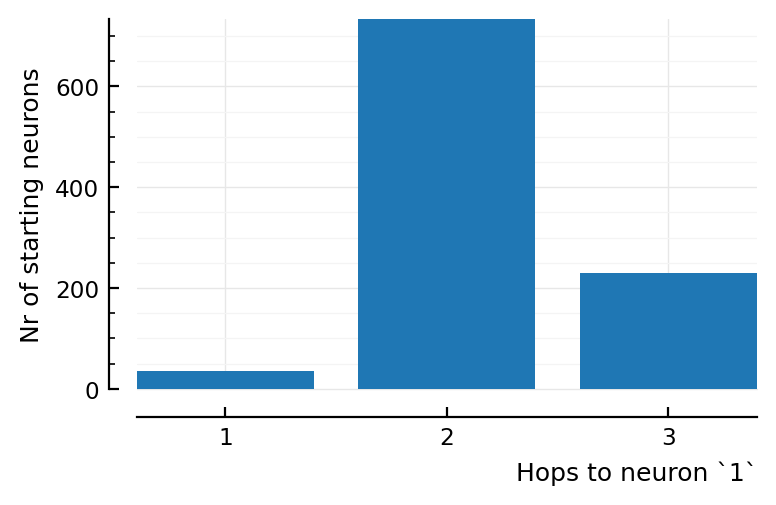
So most neurons have only one neuron in between; and the rest only two. No neurons have more than that.
For the whole network (all-to-all):
dist_matrix_as_vector = reshape(D, prod(size(D)));
cm_full = countmap(dist_matrix_as_vector)
delete!(cm_full, 0)
Dict{Int64, Int64} with 3 entries:
2 => 759845
3 => 199561
1 => 39594
hops = collect(keys(cm_full))
nr_neurons = collect(values(cm_full))
_, ax = plt.subplots()
ax.bar(hops, nr_neurons)
set(ax, xlabel = "Shortest path length", ylabel = "Nr of neuron pairs", xminorticks = false)
ax.set_xticks(hops); # `set` sets its own xticks
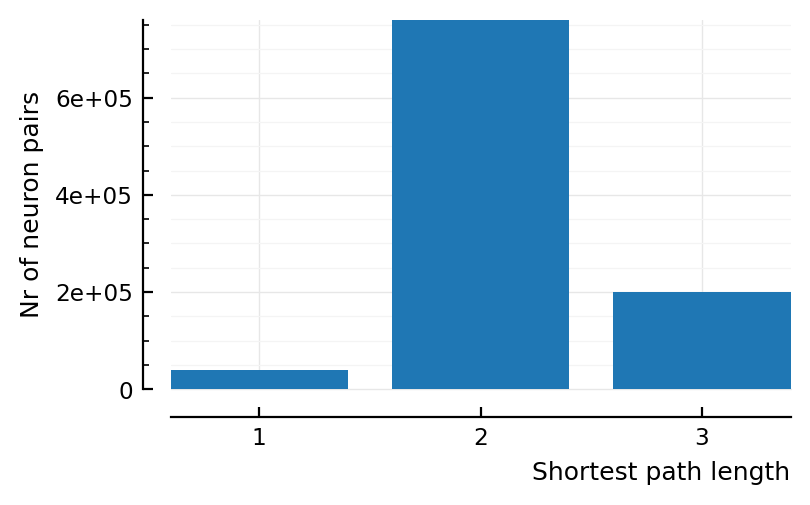
Same conclusions when looking at all neurons as target as when only looking at neuron 1 as target: most have just one neuron in between, the rest only two, no paths longer than 3 hops / synapses.
So in other words, our detected-but-not-connected are not special in that they only have one neuron in between.
Why are they still detected?
– and mostly consistently so between shuffle rng seeds.
STAs are mostly downwards. Are the in-between neurons inhibitory?
In between neuron type¶
paths = shortest_path.(signif_unconn, m)
in_between_neuron = [p[2] for p in paths if length(p) == 3]
6-element Vector{Int64}:
66
66
831
169
565
11
[s.neuron_type[n] for n in in_between_neuron]
6-element Vector{Symbol}:
:exc
:exc
:inh
:exc
:exc
:exc
So no.
Ah but we found only one shortest path. There are likely multiple.
Maybe the detected ones have more inhibitory in between, or stronger connections, or higher firing neurons. So we could compare these measures between a detected and an undetected unconncted neuron.
All paths¶
Let’s start with all paths of length 2 (edges; so 3 neurons, including start and target).
function all_paths_of_length(k::Int, start::Int, target::Int, outputs::Dict{Int, Vector{Int}} = s.output_neurons)
paths = [[start]]
for i in 1:k
newpaths = []
for path in paths
push!(newpaths, [[path..., o] for o in outputs[last(path)]]...)
end
paths = newpaths
end
return [p for p in paths if last(p) == target]
end;
insignif_unconn = [n for n in tested_unconn if n ∉ signif_unconn]
show(insignif_unconn)
[2, 3, 6, 7, 8, 9, 10, 12, 13, 15, 17, 18, 19, 20, 21, 23, 24, 25, 26, 27, 28, 29, 30, 31, 32, 34, 35, 36, 38, 39, 40, 41, 42, 43]
signif_unconn
6-element Vector{Int64}:
4
5
14
16
22
37
all_paths_of_length(2, signif_unconn[1], m)
3-element Vector{Vector{Int64}}:
[4, 66, 1]
[4, 516, 1]
[4, 928, 1]
all_paths_of_length(2, insignif_unconn[1], m)
3-element Vector{Vector{Int64}}:
[2, 70, 1]
[2, 418, 1]
[2, 831, 1]
Now do this for all tested neurons, and get the type of the in-between neurons.
Compare between detected (false positive) and not detected (true negative)¶
Start simple: number of paths of length 2, for each.
macro plothists(expr, title = "", bins = 10)
return quote
vals_sig = [$expr for n in signif_unconn]
vals_insig = [$expr for n in insignif_unconn]
plt.hist([vals_sig, vals_insig], $bins, align="left",
label = ["Detected as connected", "Not detected as connected"])
plt.legend()
plt.xlabel($title, loc="center")
plt.ylabel("Number of tested,\n unconnected neurons")
end
end;
@plothists length(all_paths_of_length(2, n, m)) "Number of length-2 paths to target neuron `$m`" 0:7;
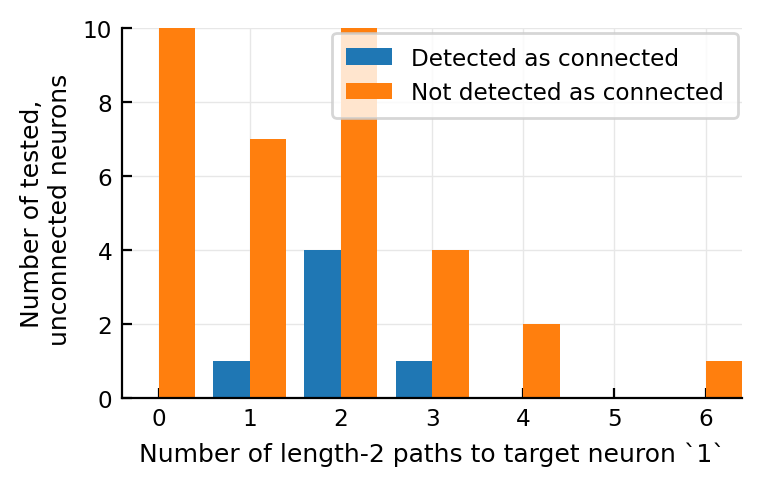
No big diff it seems. The detected maybe have more paths.
Next, nr of inhibitory in between.
type_of_in_between_neuron(path) = s.neuron_type[path[2]]
num_inh_in_between(start_n) =
count([type_of_in_between_neuron(p) for p in all_paths_of_length(2, start_n, m)] .== :inh);
@plothists(num_inh_in_between(n), "Number of length-2 paths where \nneuron in between is inhibitory", 0:3)
plt.xticks(0:2);
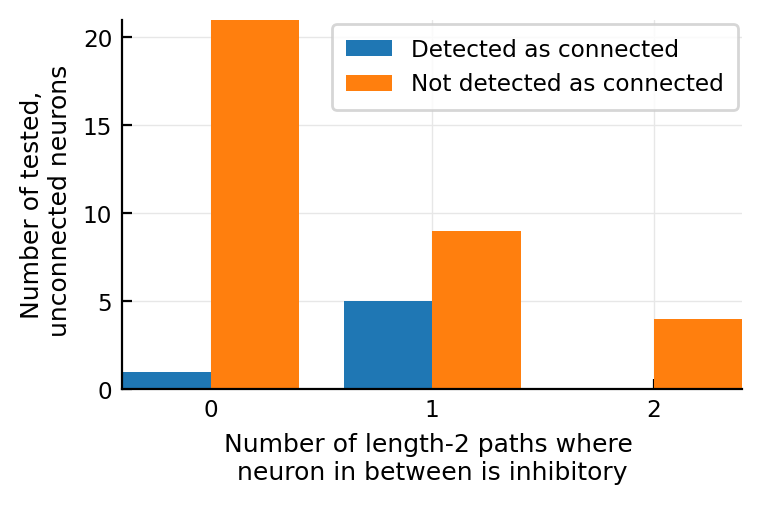
~~So no, not more inhibitory in between; on the contrary, there’s other neurons with more inhibitory in between, that didn’t get detected.~~
When I actually plotted it, I did see diff :)
The detected-as-connected neurons have more inhibitory neurons as in-between to our target neuron.
Next, firing rates.
firing_rate_of_in_between_neuron(path) = s.spike_rates[path[2]]
mean_or_zero(x) = isempty(x) ? 0 : mean(x)
mean_fr_in_between(n) =
mean_or_zero([firing_rate_of_in_between_neuron(p) for p in all_paths_of_length(2, n, m)]);
@plothists mean_fr_in_between(n) "Mean firing rate of in-between neuron (Hz)";
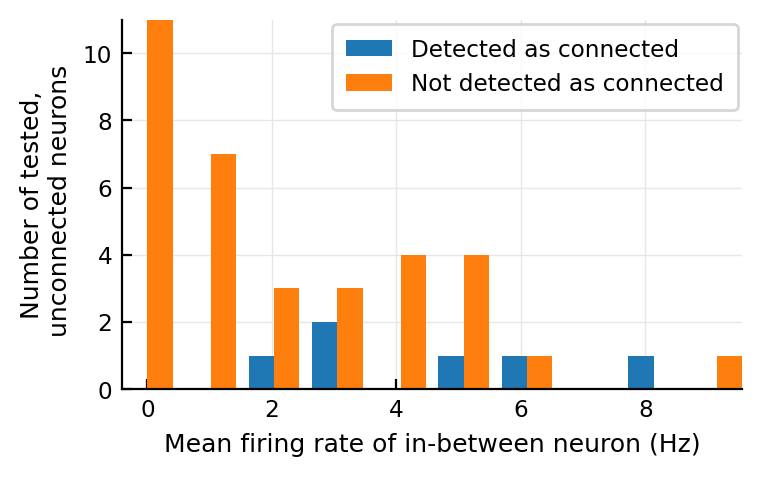
Again, seems like a bit higher firing rate.
It might make more sense to look at the sum of firing rates, as the number of paths is not equal between ‘pre’-neurons:
@plothists total_firing_rate_in_between(n) "Sum of firing rates of in-between neurons (Hz)";
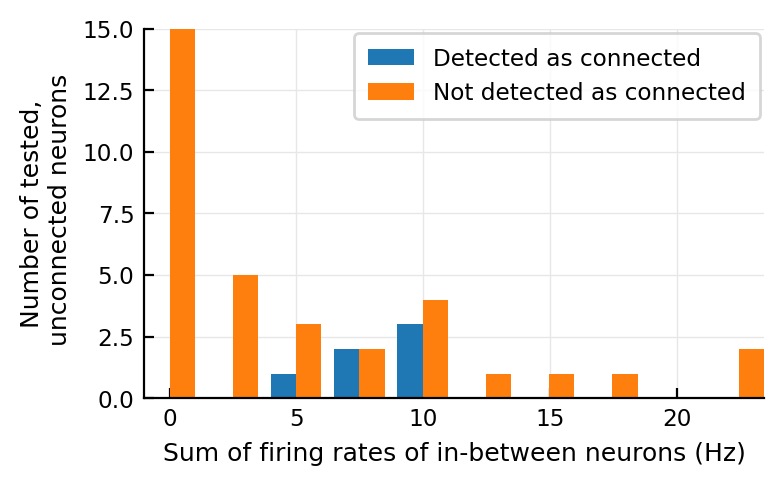
The distribution still seems higher.
What about those non detected ones at the far right? What does their STA look like? Why are they not detected? See the section after the next one.
STAs of non-detected¶
We repeat the STAs of the detected unconnected here..
STAs = [calc_STA(v, s.spike_times[n], p) for n in signif_unconn]
ylim = [minimum([minimum(S) for S in STAs]), maximum([maximum(S) for S in STAs])] ./ mV
for n in signif_unconn
_, ax = plt.subplots(figsize=(2.2, 1.8))
plotSTA(v, s.spike_times[n], p; ax, ylim)
end
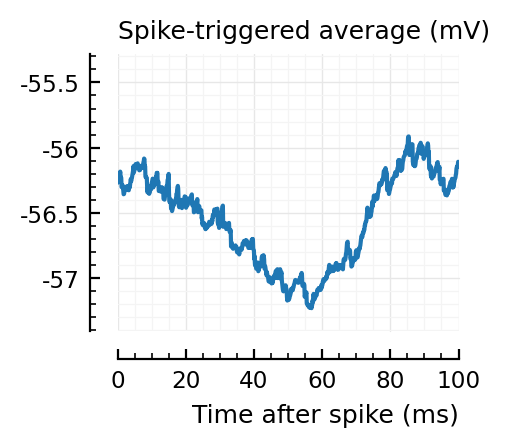
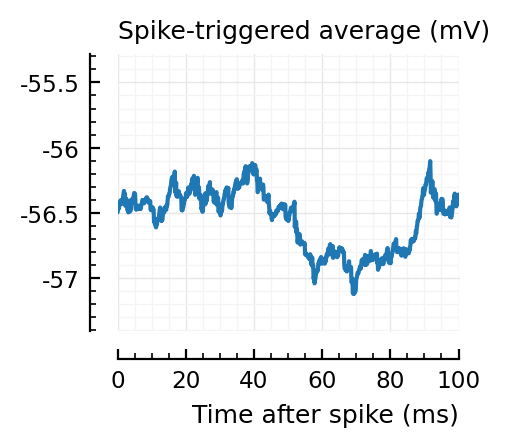
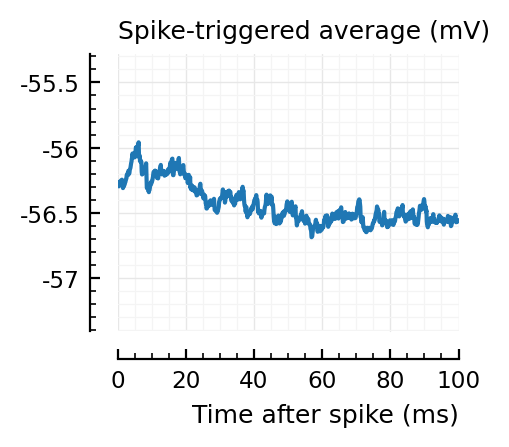
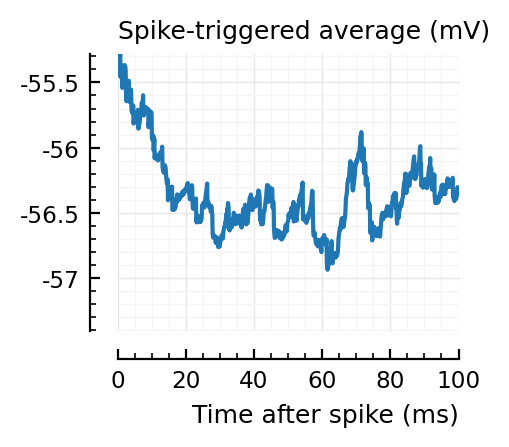
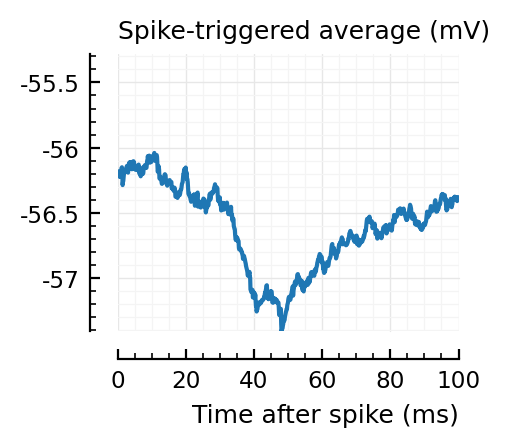
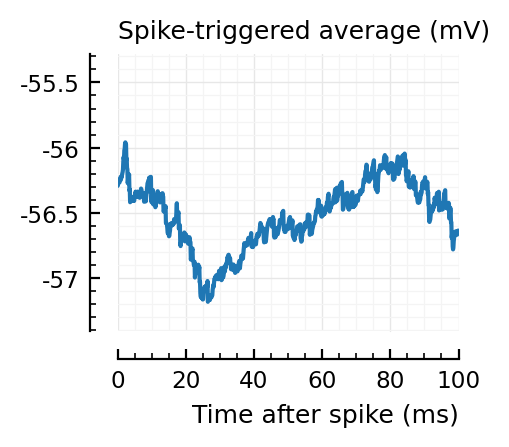
..to then compare them with some STAs of the non-detected unconnected:
for n in insignif_unconn[1:6]
_, ax = plt.subplots(figsize=(2.2, 1.8))
plotSTA(v, s.spike_times[n], p; ax, ylim)
end
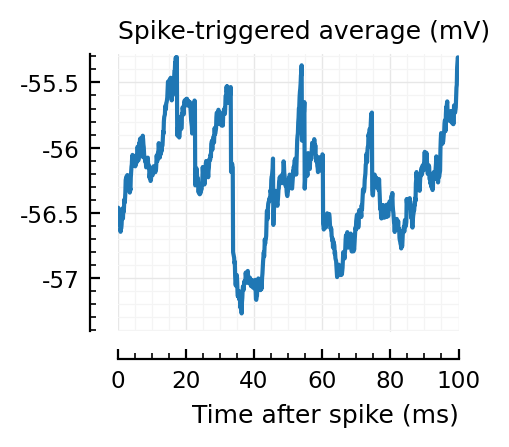
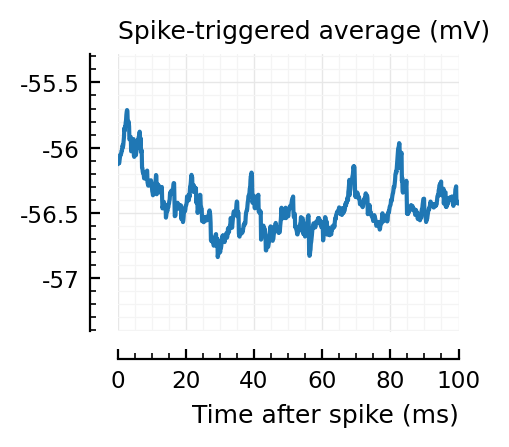
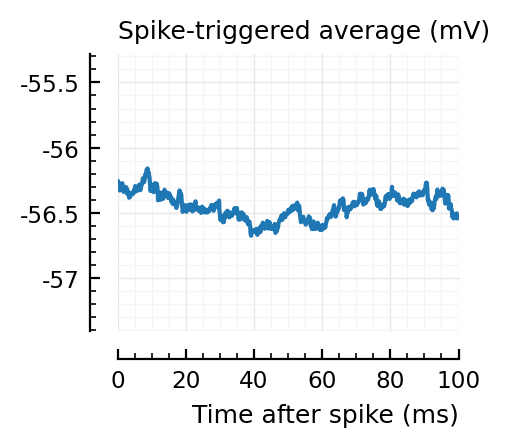
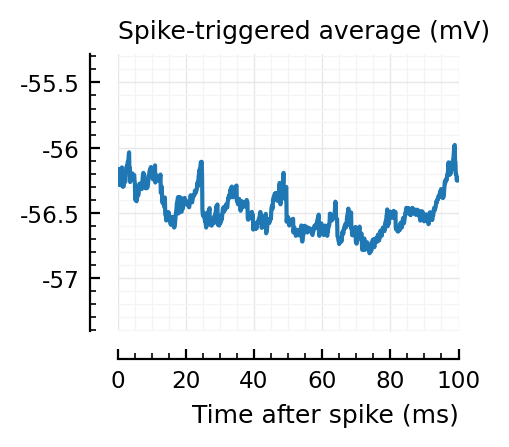
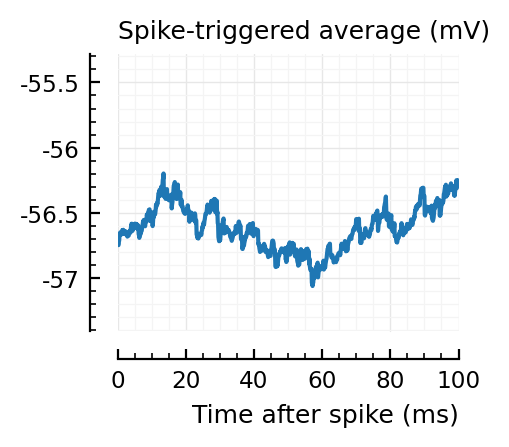
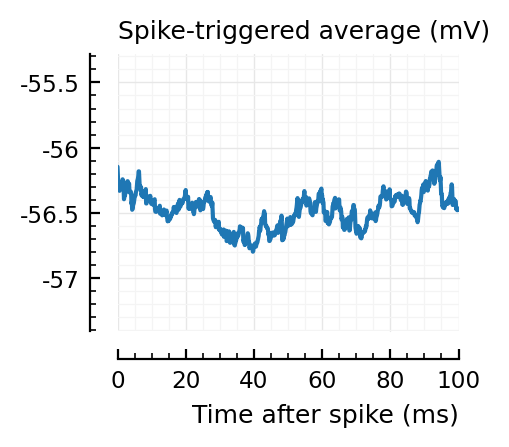
Strangely, these STAs do not seem much smaller than the detected ones..
The first one is very high. What was it’s p-value?
perf.p_values.unconn[1]
0.55
Check (we repeat this as it the shuffle is different each time):
mean([test_connection(v, s.spike_times[ii.unconnected_neurons[1]], p) for i in 1:10])
0.561
(Probably same, check ok)
Quite interesting.
Here the usefulness of the shuffle test (instead of looking at the absolute STA height values) comes up.
Maybe it is so high because the neuron has only few spikes (and thus a noisy STA).
s.spike_rates[ii.unconnected_neurons[1]]
0.242
Indeed, quite low :)
Non detected but the in-betweens fire lots¶
i = argmax([total_firing_rate_in_between(n) for n in insignif_unconn])
n = insignif_unconn[i]
7
all_paths_of_length(2, n, m)
6-element Vector{Vector{Int64}}:
[7, 516, 1]
[7, 681, 1]
[7, 710, 1]
[7, 766, 1]
[7, 897, 1]
[7, 928, 1]
num_inh_in_between(n)
2
plotSTA(v, s.spike_times[n], p);
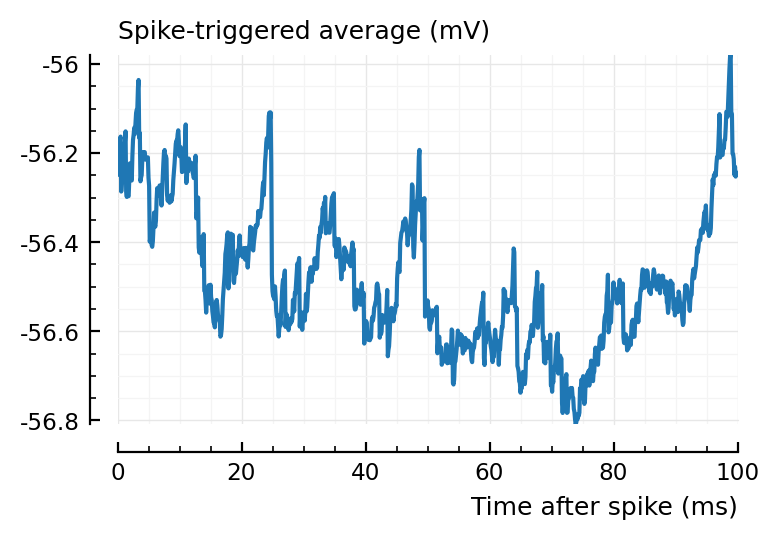
This STA is indeed quite random and small.
s.spike_rates[n]
1.09
Ah, what about this for the significant ones?
@plothists(s.spike_rates[n], "Firing rate (Hz)");
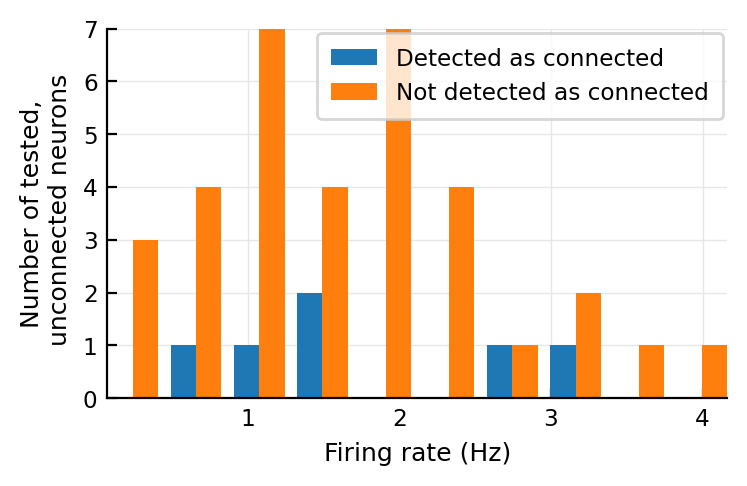
No clear diff.
Summary¶
The network is highly connected: every neuron is maximum three hops (edges, synapses) away from any other. Most only two hops.
Excess false positives (above the expected α = 5%) seem stable between shuffle seeds and are thus not flukes.
Their STAs often look like inhibitory STAs / PSPs.
These detected but not-directly-connected ‘pre’ neurons seem to have
More paths to the voltage-recorded neuron
More inhibitory neurons on these paths
Higher firing neurons on these paths
They do not have a higher firing rate.
Low firing unconnected neurons have high STAs (as not enough spikes to average out the noise); but these get correctly not detected thanks to the shuffle test.